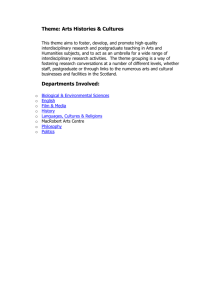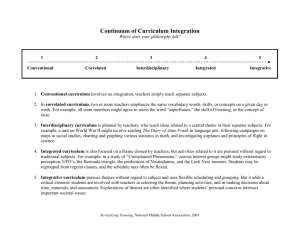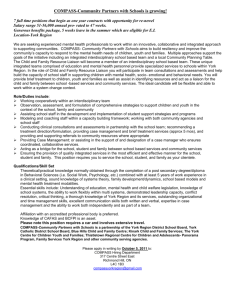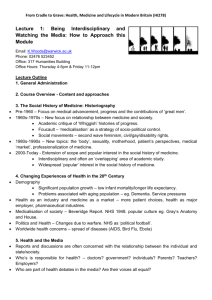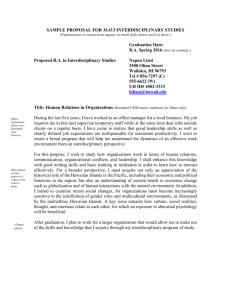Position paper - WordPress.com
advertisement
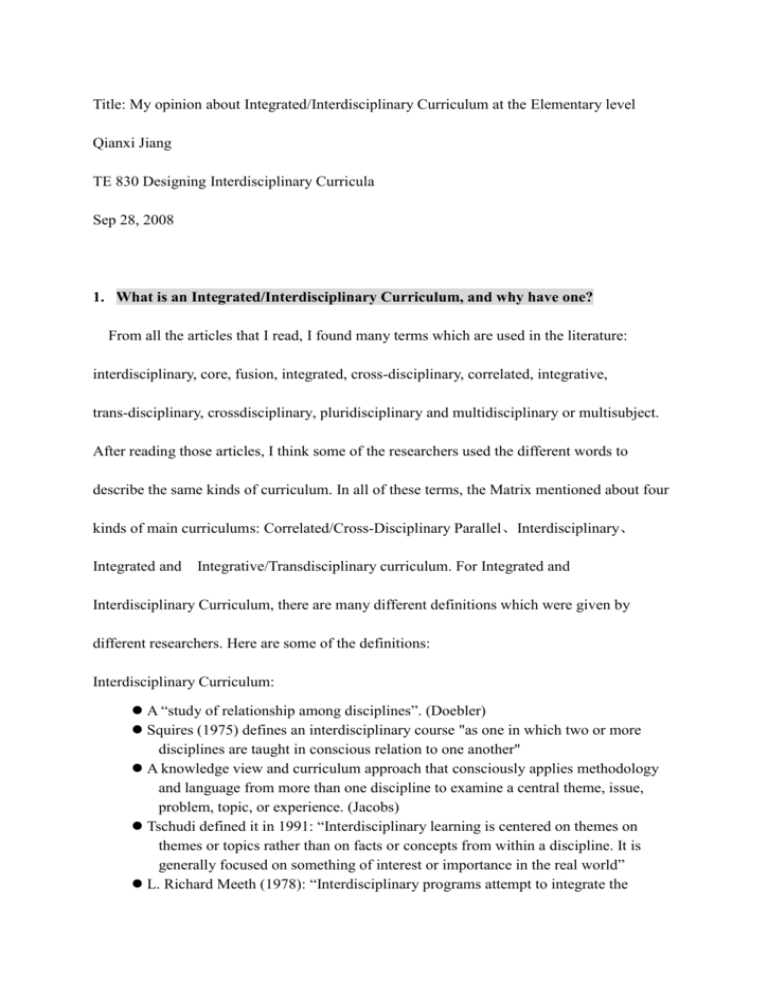
Title: My opinion about Integrated/Interdisciplinary Curriculum at the Elementary level Qianxi Jiang TE 830 Designing Interdisciplinary Curricula Sep 28, 2008 1. What is an Integrated/Interdisciplinary Curriculum, and why have one? From all the articles that I read, I found many terms which are used in the literature: interdisciplinary, core, fusion, integrated, cross-disciplinary, correlated, integrative, trans-disciplinary, crossdisciplinary, pluridisciplinary and multidisciplinary or multisubject. After reading those articles, I think some of the researchers used the different words to describe the same kinds of curriculum. In all of these terms, the Matrix mentioned about four kinds of main curriculums: Correlated/Cross-Disciplinary Parallel、Interdisciplinary、 Integrated and Integrative/Transdisciplinary curriculum. For Integrated and Interdisciplinary Curriculum, there are many different definitions which were given by different researchers. Here are some of the definitions: Interdisciplinary Curriculum: A “study of relationship among disciplines”. (Doebler) Squires (1975) defines an interdisciplinary course "as one in which two or more disciplines are taught in conscious relation to one another" A knowledge view and curriculum approach that consciously applies methodology and language from more than one discipline to examine a central theme, issue, problem, topic, or experience. (Jacobs) Tschudi defined it in 1991: “Interdisciplinary learning is centered on themes on themes or topics rather than on facts or concepts from within a discipline. It is generally focused on something of interest or importance in the real world” L. Richard Meeth (1978): “Interdisciplinary programs attempt to integrate the contributions of several disciplines to a problem, issue, or theme from life.” Interdisciplinary Units/Courses: In this design, periodic units or courses of study deliberately bring together the full range of disciplines in the school’s curriculum: language arts, math social studies, and science; and the arts, music, and physical education. The main point is that the designers attempt to use a full array of discipline-based perspectives. (Jacobs) From all the definitions above, we can conclude three mutual elements: More than one discipline Issue/theme-based Not all the researchers mentioned that interdisciplinary curriculum focuses on the real world. They are more concentrated on bringing together the full range of disciplines in the school’s curriculum within a theme. In this approach, teachers are more likely to find the topic in the ongoing class and organize the curriculum depending on their schedule. In contrast to the Interdisciplinary Curriculum, Integrated Curriculum also has more than one discipline, based on issues and themes. From all the readings, the Integrated Curriculum focuses more on the student’s questions and interests which link to the student’s lives. The purpose is that it is more likely to let the students have the ability to deal with real problems. The design of the Integrated Curriculum, it is also from the teacher’s view of students’ needs. Here are some definitions from different researchers: “An integrated study is one in which children broadly explore knowledge in various subjects related to certain aspects of their environment” (MacIver 1990) “Integrated curriculum is often organized around student-selected themes, problems, and investigations, providing opportunities for student choice can also enhance student interest and motivation” (Stipek, 1993) Dressel (1958) defined that Integrated is when a teacher presents a unified or integrated conception of some form of knowledge to the student. Integrated-Day Model: This model is a full day program based primarily on themes and problems emerging from the child’s world. The emphasis is on an organic approach to classroom life that focuses the curriculum on the child’s questions and interests rather than on content determined by a school or state syllabus. (Jacobs) However, I found that the Chapter 1 What is Integrated Curriculum of the Drake & Burns’s book Meeting Standards Through Integrated Curriculum has a totally different point of view in Integrated and Interdisciplinary curriculum. “It acts as a bridge to increased student achievement and engaging relevant curriculum ,and it seems to be ‘a matter of degree and method’”—The book defined three approaches to integration: multidisciplinary, interdisciplinary, and transdisciplinary, which means the Integrate Curriculum is the big idea and Interdisciplinary Curriculum is one of the three sub-approaches. In contrast to the explanation in the other articles, I think Drake & Burns just use the word “Integrated Curriculum” to stand for designing curriculum with integration approach. Based on all the articles, one can conclude that the Integrated and Interdisciplinary curriculum are under the idea of curriculum integration. But, the integration level of Integrated Curriculum is higher than Interdisciplinary Curriculum. It focuses more on the real life issues and involves the student’s ideas in the curriculum design. The critical element is that regardless of whether it involves skills, concepts, content, points of view, or methods, these two kinds of curriculum involve bringing together two or more things under one roof and by exploring a general theme through various discipline-based activities. Still, both the two approaches content, methods, processes or skills taught remain bound to the primary discipline from which they come. 2. How I conceive of I/C and its Potential Importance? My definition: Integrated/Interdisciplinary is an approach to design the theme -oriented curriculum by combining related content and skills in more than one discipline and based on the student’s needs for real life, which is in order to let the students understanding of the knowledge become deeper and wider and to develop their life skills. Compared to Jacobs’s definition, my definition focuses more on student’s needs and developing students’ real life skills. I’ll unpack each part of my definition and explain the difference later in this paper. Let me introduce my teaching area and interest first: I taught kindergarten and I would like to stay in the elementary level in my future teaching. I believe that in elementary level, to teach the students understand the knowledge and let them acquire the skills to deal with the real life issues are both very important. From the sociological perspective, the three micro-elements which affect student’s achievements are: family, school and community. These three environments even have a stronger influence when students in the elementary level. So, I believe that in elementary education, it is extremely important to involve the parents and community into the school teaching and the student’s learning, because to educate the student is not only the school’s or the family’s responsibility. Moreover, I believe that the big idea of education, especially elementary education, is to help children’s development and socialization. To let children be socialized, the school, family and community should collaborate together to provide students a better teaching and learning environment. Some main points in my definition: “design the theme -oriented curriculum by combining related content and skills in more than one discipline” From all the literature, I can conclude that I/C curriculum is based on more than one discipline, maybe two, three, or even more subjects, which is depends on the point that teachers want to make. Also, the curriculum, not only combines the related content in different subjects, but also combines the skills which students could use in wider areas. Theme-oriented is a typical way to organize the curriculum. “based on the student’s needs for real life” As I’ve mentioned above, students live in the real life. They play different roles in different social context. To be better socialized, students should learn not only the knowledge but also the skills for living in this world, such as the ability to communicate with each other. When teachers are designing I/C curriculums, student’s needs must be involved in. The real life content of elementary level students is mostly in family, school and community. So, the collaboration between school, family and community is needed. Moreover, the school should take on more responsibilities in offering some strategies to promote this collaboration. The teacher, who has a very important role in school teaching, should work together with and think about better ways to communicate with families and communities based on their teaching needs. In addition, in my definition, “based on the student’s need” has another point which is different than Jacobs’s. I believe that in kindergarten, teacher should pay more attention to the student’s individual needs as well. Kindergarten classes are always more flexible and are also have more teachers or teaching assistants. It enables teachers to pay attention to students’ individual needs. Different student has different needs. Especially in kindergarten class, at the physically development level, girls grow fast than boys. There is an obvious difference between girls and boys in the same age. Even in the same gender, students who have a half year age gap are very different. Moreover, the difference doesn’t only appear in the physical area. How to balance the difficulty level of the curriculum is a very important work as well. 3. Waking the Talk and Tightrope My long-term goal and the specialty of my I/C definition is already mentioned in the second part of my paper, and is: to promote children’s all-around development based on their needs. But there are some difficulties that could become obstacles to achieving the long-term goal and to implementing I/C curriculum in elementary schools: For schools: Every school has its own school culture and standards. Will the school support the teacher developing curriculum which is quite different than the school culture? If the school would like to support the I/C curriculum that designed by a teacher, can they supervise the curriculum well and provide solid support? It also requires the administrator to understand the content and the purpose of the curriculum. For teachers: There are many constraints for teachers. First, the level of teachers plays a very important role of the achievement of I/C curriculum. My definition of I/C curriculum has a really high standard for teachers. To focus on student’s individual needs, teachers should have the ability to find out the needs first. And then design a way to fulfill their needs. I/C curriculum also require teachers to work together. It brings in another problem and requirement, which is the communication ability of teachers. Also, teachers should find strategies to involve family in teaching. Are they willing to communicate with different families? In addition, teachers are already very busy with their own life. For students: Every student is different. There are so many kinds of student: shy students, too active students, gifted students, disabled students…… Do they understand the instruction from the teacher? Can they collaborate with each other? Do they really show their needs by asking questions? For families: Different families also have their own style. Sometimes it is hard to let the parents understand the purpose of the curriculum. Moreover, will parents communicate with teachers? Will families support the teacher’s ideas? Even whether the student has a health family or not is a problem too. However, there are also some opportunities for implementing I/C curriculum. If teachers and schools could communicate well with families and communities, the three micro-elements which effect the student’s achievement would work together and provide the student a very good learning and exploring environment. Also, if teachers from different subjects could communication well, not only could that bring the good curriculum plans but it also could enhance the relationships between teachers, which would provide teachers a better work environment as well. Moreover, students will benefit a lot if the I/C curriculum works well. So, to prevent and solve those problems above, I think there are some solutions: 1. Implement communicate strategies based on the need of the class To improve the communication between family and school, teachers can find some good strategies based on the background of the class and the family, such as weekly newsletter, family journal, home visits, individual meeting, teacher-parents conferences…… 2. Team work is a very good way to balance the different levels of students. Children can learn a lot by observing others. Team work is a very good way to let students working together, helping and learning from each other. Moreover, since team work needs coworkers to communicate with each other a lot, working together could also provide a environment for them to develop communication skills. Also, in every team, there is a team leader; students can take turns being the leader and having this experience. 3. Getting support from the researcher. When I was doing my internship, I always talked to the professors in my university. They gave me many suggestions. Sometimes, teachers couldn’t find their own problems; they needed someone who understands the theories very well to supervise them. In addition, teaching and learning is a combination. Researchers always have the latest information which could they share with teachers and enable teachers to learn more and connect to the academic area. Reference: Heidi Hayes Jacobs (1988).Chapt1&Chapt2 Implementation Interdisciplinary Curriculum: Design and Susan M. Drake and Rebecca C. Burns (2004). What is integrated curriculum? S. Mathison, M.Freeman (1997). The logic of interdisciplinary studies. Kathy Lake (1994). Integrated Curriculum James A. Beane. Organizing the Middle School Curriculum Grady(1994). Interdisciplinary Curriculum: A Fusion of Reform Ideas. Vars, Gordon F. - Beane, James A. (2000). Integrative Curriculum in a Standards-Based World T. Mason (1996). Integrated Curricula: Potential and Problems. M .Adler, S. Flihan (1997).The Interdisciplinary continuum: reconciling theory, research, and practice.


